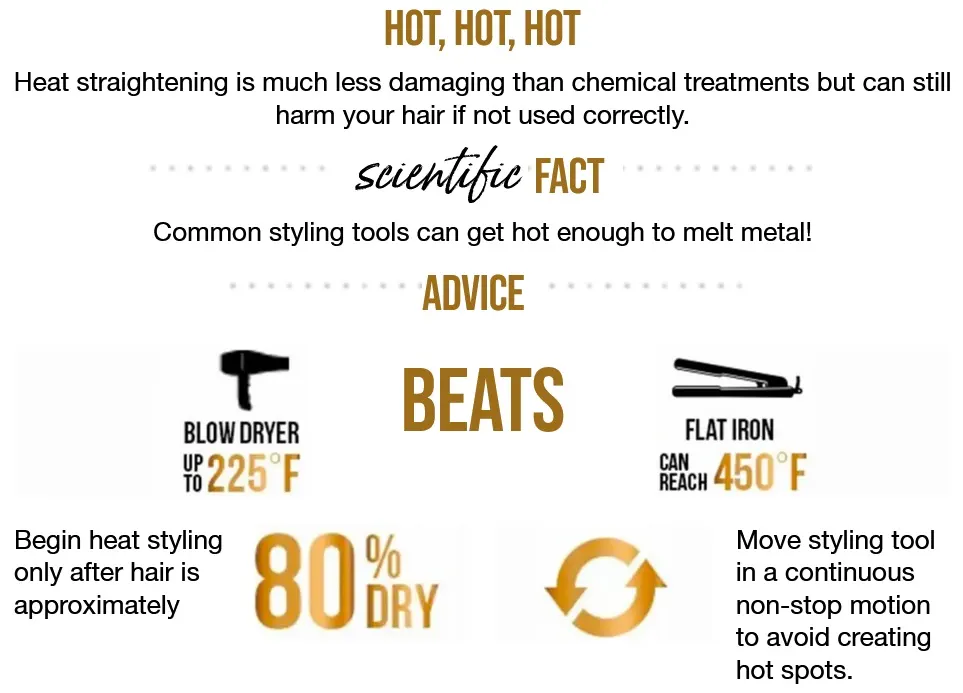Smooth hair is high on everyone’s beauty covet list. But with so many options for how to get it, choosing the right method can be overwhelming. So we’re here to break down the difference, and to help you decide which straightening strategy is best for you. Here are your hair smoothing and straightening options:

Smooth hair is high on everyone’s beauty covet list. But with so many options for how to get it, choosing the right method can be overwhelming. So we’re here to break down the difference, and to help you decide which straightening strategy is best for you. Here are your hair smoothing and straightening options:
Chemical Straightening: What it is: The most permanent of all of the smoothing methods, it can inflict the most damage on your hair. In this process, a chemical cream – often an alkali - is applied to “relax” the curls, breaking hair’s protein bonds. The problem with hair relaxing, according to Dr. Amy McMichael, Dermatology Professor at Wake Forest, is that over time, there is an overlap where the chemical is placed. “As we apply the chemical to the new growth,” she explains, “it overlaps with what’s already been treated, and as a result of that, all of those areas are a bit more weakened. Additionally, with chemical hair relaxers, many people will also use heat on top of it, so you end up compounding damage on top of damage.” Further, after chemical relaxing, washing your hair for a few days is discouraged, although conditioning is recommended to help avoid scalp irritation. Good for: Anyone with highly coiled, curly hair. Administered by: A stylist only. Trained professionals are best equipped to determine which process is best for your specific hair type. Lasts: Until the hair grows out.
Japanese Straightening: What it is: Falling between Chemical Straightening and Brazilian Keratin treatments in level of damage inflicted, this process relies on the chemical ammonium thioglycolate to break down hair’s protein bonds, changing the structure and texture of the hair. Then the hair is painstakingly flat ironed straight, and a hydrogen peroxide neutralizer is applied to reform the bonds and “lock in” hair’s new smooth shape. For 48 hours post‐treatment, you’re forbidden from getting hair wet, pinning it or even tucking it behind your ears to avoid damaging the shape. That takes serious discipline! Good for: Virgin hair that has not been color-treated, and for women who don’t want to curl their hair again afterward (because it won’t hold). Administered by: A stylist only. Trained professionals are best equipped to determine which process is best for your specific hair type. Lasts: 4-6 months
Keratin Treatment (Brazilian Blowout)What it is: A process that “smooths out” the hair without actually breaking any of the chemical bonds, so it will eventually return to its original texture. But if that sounds too good to be true, it’s because it is. The cost of this frizz freedom is the use of formaldehyde, which has been linked to serious overall health issues. The immediate danger to your hair, on the other hand, comes in the intense and prolonged heat used during the process. Formaldehyde-free options are available, however. Should you decide to change your style, Keratin Treatments also allow hair to be re-curled afterward, unlike Japanese Straightening, which prevents hair from holding curl. As for avoiding wetness post- treatment, similar to its Japanese Straightening counterpart, both treatments require longer periods of non-washing afterwards. Good for: Slightly wavy, frizzy, or previously processed hair, not for excessive curl. Administered by: A stylist only. Trained professionals are best equipped to determine which process is best for your specific hair type. Lasts: Around 3 months
Blow Dry + Smoothing Serum: By far the least damaging to your locks than the rest of the list, this easy-to-do process removes water from hair via heat styling and resets it straight. “Make sure to use a heat protecting serum to help seal the hair, and use a lower heat setting while blow drying,” says Dr. Jennifer Marsh, Pantene Research Fellow and expert in damaged hair. “When using heat, above 190 degrees Celsius (374 degrees Fahrenheit) – roughly equivalent to the heat on your flat iron’s highest setting – it will cause denaturing to occur or degradation of the hair’s protein.” And unlike the other processes, this version of styling with a protective product like Pantene’s [fill in serum name] is simple and safe to do at home - not to mention cost friendly. Safer for your hair and inexpensive? Yes, please. Good for: Women who want to maintain the fundamental structure of their hair.Administered by: You, or a stylist if desired. As there are no harmful chemical processes involved, a do‐it‐yourself approach is welcome. Lasts: 1‐2 days, and has to be redone after every wash. Nothing’s perfect, after all.
But before you set out on your pursuit of sleek hair, there are a few things to remember, according to Dr. Marsh. It’s important to note that there’s a degree of variability in the results of all of these methods – what looks one way for your best friend might look different on your own hair. It ultimately comes down to the hair you start with, its unique structure and how much curl you’re attempting to smooth or remove. Lastly, choosing the least damaging option is never a bad idea, as premature breakage can cause those dreaded flyaways and make growing your hair out for styling more difficult.

